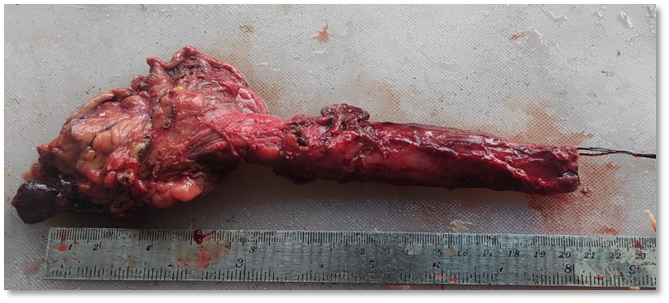A clinicopathological study of esophageal squamous cell carcinoma with special reference to Cyclin-D1 in tumour cells
Keywords:
Esophageal squamous cell carcinoma (ESCC), Histological grades, Metastasis, Immunohistochemistry, Cyclin-D1Abstract
Introduction: Esophageal squamous cell carcinoma (ESCC) is one of the lethal carcinomas with a high incidence rate in Asia and it stands at 5th position in India in terms of incidence. The cyclin-D1 gene plays an important role in its carcinogenesis. We aimed to analyze the various clinicopathological parameters associated with ESCC. Cyclin-D1 expression and its role as a prognostic marker are also evaluated. Cyclin-D1 being a marker for cell proliferation was used in this study. The primary objectives of the current investigation were to investigate the expression of Cyclin-D1 in ESCC and to establish a relationship between the expression patterns of Cyclin-D1 and the histopathological features of the ESCC.
Materials and methods: We examined 134 samples of ESCC in the Department of Pathology, Silchar Medical College and Hospital and categorized them histologically as well-differentiated, moderately differentiated, and poorly differentiated. For assessing the expression of Cyclin-D1, immunohistochemistry was done in all these cases.
Results: Out of 134 cases, 38.8% were in 6th decade of life. Males were more commonly affected than females. The association between anemia, clinical features, habits, and ABO-Rh grouping was analyzed. The low-income population was found to be associated with its incidences. 63.4 % of cases were moderately differentiated, followed by 34.3% well differentiated and 2.2% poorly differentiated carcinoma. The Middle third of the esophagus was involved commonly. Nodal metastasis was found in 97.5% of cases and 17.5% distant metastasis. Cyclin–D1 expression was seen in 43.5% of well-differentiated carcinoma, 65% of moderately differentiated squamous cell carcinoma, and 66.7% of poorly differentiated carcinoma.
Conclusion: The study found an association between ESCC and low-income groups and males in their 6th decade. However, moderately-differentiated squamous cell carcinoma was identified as the most common type in this study. Furthermore, the finding that Cyclin-D1 expression was more prominent in poorly differentiated carcinoma of the esophagus could potentially lead to more targeted treatment options in the future. Overall, this study provides valuable insights into the characteristics of ESCC and can help guide further research in this area.

Additional Files
Published
How to Cite
License
Copyright (c) 2024 Payel Hazari , Monoj Kumar Deka, Arindam Das, Anuradha Talukdar

This work is licensed under a Creative Commons Attribution-NonCommercial 4.0 International License.
